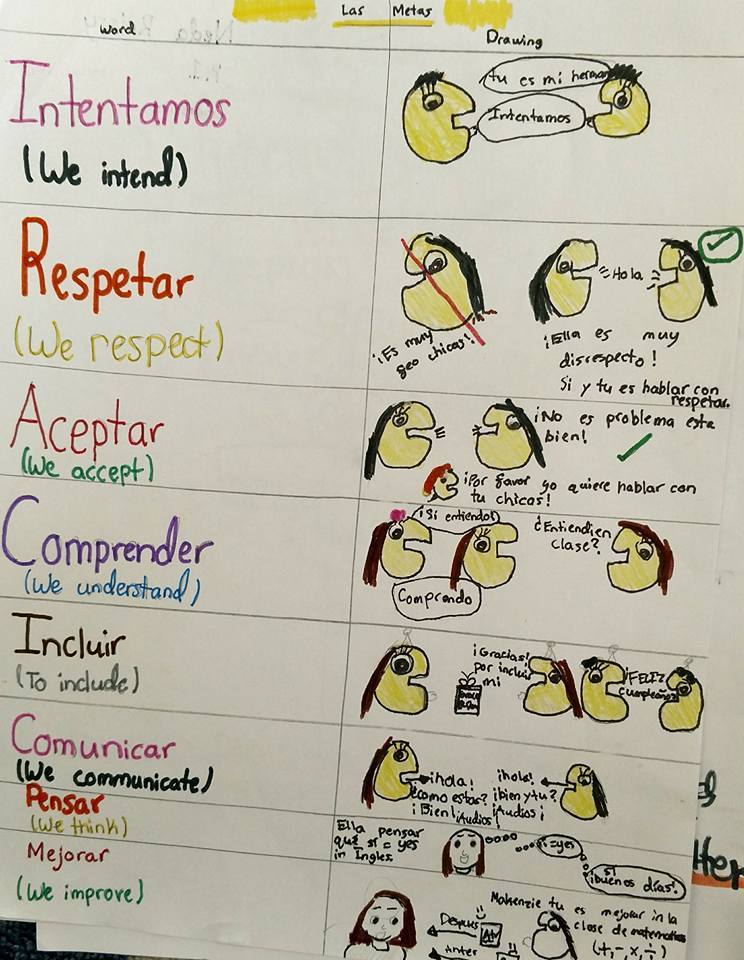Oh the possibilities!!
First, let me be clear. TPRS/CI can work with ANY kind of seating arrangement.
So let’s look at seating from the basic elements:
The physical arrangement of the room creates a certain atmosphere which can really affect the “tone” of the class. Each teacher has the right to choose the arrangement that works best! There is no ‘best” way.
Traditional Rows: It is absolutely easier to put kids in “traditional” rows, and create a seating chart, in alphabetical order in order to take attendance. Especially if you have very large numbers. Make a seating chart, in two days they will remember where they sit, you get used to certain faces in certain seats and taking attendance/learning names is much easier than it is in nearly any other option.
Whenever possible, have a clear lane to walk in on all four sides of the room. We always want to be within a few feet of each student when it’s necessary.
If you have a lot on your plate, or you/your students need a lot of structure, use this option….especially to start with! You can always change seating as the year progresses!
Theater Seating: Students are in rows, but angled towards the center of the room, especially the outer rows. This allows the entire class to focus on the area in the front of the room which now becomes a “stage”. Because it is slightly different than the “traditional’ rows, it can help teachers and students to step into the new mindset that being in a CI class requires, without being a shock to the system.
Volleyball Seating: Students are in rows, facing the center of the room and the “stage” can then be the front, back or center of the room as needed. There are many benefits to this arrangement. The biggest challenge to this arrangement is that students are now facing each other and may have to learn to interact as a class without distracting each other.
Semi-Circle This is one of my favorites…and it can be done in several rows of seats. It feels somewhat “informal”, but offers a sense of structure for those who need/want it.
Circle: Not all rooms are large enough to allow for students to sit in a circle, but it can be a great arrangement for many smaller groups! (My students often lovingly referred to it as the “counseling circle.” )
Groups or pods: There are definite benefits to having students sit in groups, but also a number of challenges for the TPRS/CI teacher. It can be difficult to keep students focused when they are all facing different directions and also facing a small group of peers!
And of course, there are combinations and adaptations of the above. Remember, you can actually change the seating any time during class once you have trained students how to do that carefully and quickly. (That’s a future post!)
Assigned Seats: This is another choice that you get to make!
Some teachers, particularly at the high school and college level, do NOT assign seats. They choose the seating arrangement, but allow students to choose where to sit each day. And….each day could be different, depending on who arrives when etc.
Another option is to allow students to sit where they would like the first few days, then ask them to choose a “permanent” seat for the quarter/semester/year…once they have found a place that they feel comfortable.
The third option is to “randomly“ assign seats. The teacher strategically chooses specific locations for certain students and then randomly assigns the class to the remaining seats. All of this is done before presenting the seating chart to the students. (although even young ones are pretty savvy about what we have done and why!)
Then there is also the traditional, alphabetical arrangement mentioned above.
Seating Charts
Now that you’ve chosen a seating arrangement, think about how you will create a seating chart. Electronically? The picture feature on these is FANTASTIC! By hand? Some people prefer it. Maybe you prefer to use an app like Dojo. Check out the attendance chart I used!
Again, there is no right way. Just ask yourself three questions: Is is accurate? Is it efficient
as you take attendance and learn names?
Attendance can be time-consuming, but it is important!!! Schools are adamant now that we take and record attendance promptly and accurately. The seating arrangement we choose can affect how we take attendance.
Need a new idea? Check out this post: The Magic Attendance Poster
Also keep in mind that when there is a substitute, it is handy to have some sort of agreed upon arrangement with students about seating, attendance and behavior. So if you choose to be flexible about seating, make sure the sub doesn’t need all period to call out the roll to take attendance.
Last but not least….YOU ARE NOT REQUIRED TO HOLD ON TO ANY ONE WAY OF DOING THINGS!
If you start with one arrangement, and want to try something else, go for it!! It is not a bad thing for students to see you mixing it up, evaluating something new and making decisions. It’s a wonderful thing!
Just don’t take on more than you need to at any one time. You are important.
With love,
Laurie







